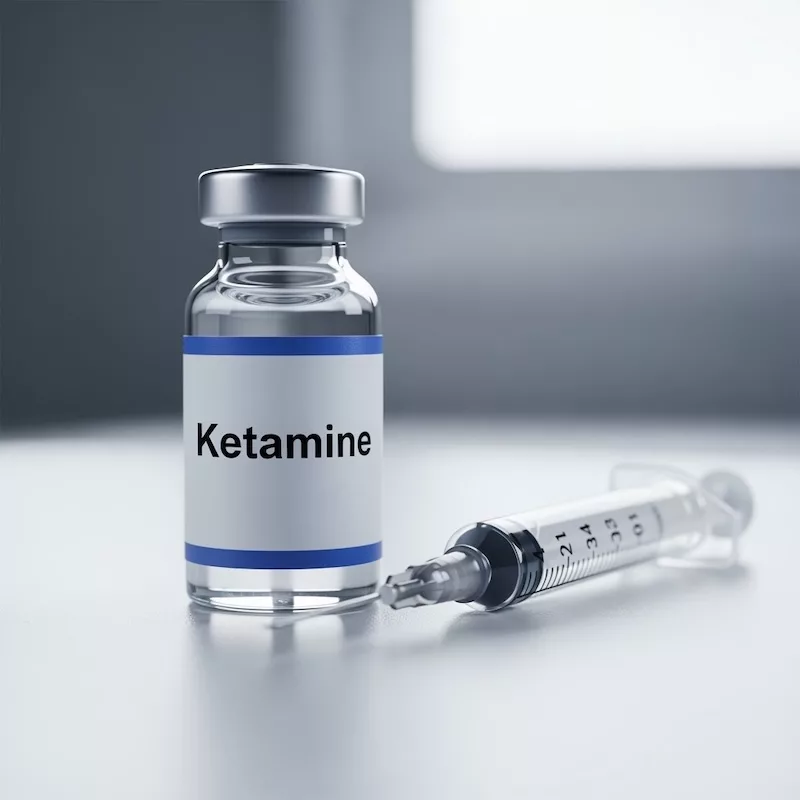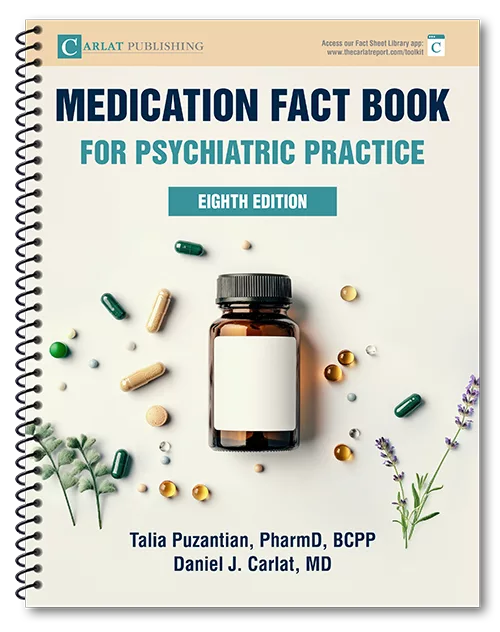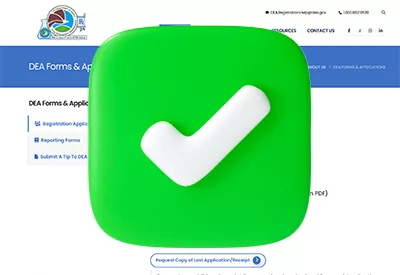The FDA just approved Ketarx for surgical pain, but the company has its eyes on depression.
Publication Date: 08/25/2025
Duration: 18 minutes, 30 seconds
Transcript:
KELLIE NEWSOME: The FDA just approved ketamine for pain, but they have their eyes on something else. Welcome to the Carlat Psychiatry Podcast, keeping psychiatry honest since 2003.
CHRIS AIKEN: I’m Chris Aiken, the editor in chief of The Carlat Psychiatry Report.
KELLIE NEWSOME: And I’m Kellie Newsome, a psychiatric NP and a dedicated reader of every issue. We’re going to interrupt our series on starting a psych med to bring you breaking news about ketamine. This month, the FDA made two critical decisions that move ketamine – the original racemic ketamine - closer to approval in depression.
CHRIS AIKEN: I’m Chris Aiken, the editor in chief of The Carlat Psychiatry Report.
KELLIE NEWSOME: And I’m Kellie Newsome, a psychiatric NP and a dedicated reader of every issue. We’re going to interrupt our series on starting a psych med to bring you breaking news about ketamine. This month, the FDA made two critical decisions that move ketamine – the original racemic ketamine - closer to approval in depression.
1. On August 8, they approved KetaRx, an intramuscular ketamine, for surgical pain.
2. Three days later, on August 11, the FDA fast-tracked a patented, intravenous ketamine - NRX-100 – toward a possible indication for suicidality in depression.
In today’s episode, you’ll learn why this matters in a world where intranasal esketamine is already approved as Spravato for depression, and how these new companies are planning to change psychiatry as they expand their products. First, let’s look at how they are even able to do this with a drug that has been on the market since 1966, when ketamine was launched as a dissociative anesthetic.
CHRIS AIKEN: Companies can claim new patents on an old drug if the FDA thinks the drug is already generic and the FDA thinks they have something new to offer. The idea here is that it’s not the chemical itself that is being patented, but a novel idea, like using doxepin at a low dose to treat insomnia. That’s how Silenor gained a patent in the 3 and 6 mg doxepin dosages in 2010. These are called “secondary patents,” and some of the ways that companies can achieve this are….
KELLIE NEWSOME:
CHRIS AIKEN: Companies can claim new patents on an old drug if the FDA thinks the drug is already generic and the FDA thinks they have something new to offer. The idea here is that it’s not the chemical itself that is being patented, but a novel idea, like using doxepin at a low dose to treat insomnia. That’s how Silenor gained a patent in the 3 and 6 mg doxepin dosages in 2010. These are called “secondary patents,” and some of the ways that companies can achieve this are….
KELLIE NEWSOME:
1. A new formulation, like XR or ODT. We saw this in 2025 with Onyda XR, a liquid version of clonidine XR that is approved for childhood ADHD.
2. A new route of administration, like we see with intramuscular antipsychotics. The new ketamine product – Ketarx for pain – looks this way. It is intramuscular. But actually, IM ketamine was already approved in 1970 for anesthesia, for use in situations where you can’t get IV ketamine started, like traffic accidents, veterinary medicine, and on the battlefield. IM ketamine got its start in the Vietnam War.
3. New combinations, like we saw with Auvelity – the bupropion-dextromethorphan combination that borrows from ketamine’s mechanism of action with the glutamatergic cough medicine, dextromethorphan. There’s also a batch of generic combos in development that are seeking FDA approval as pharmaceutical therapies for sleep apnea. We’ll cover that more in an upcoming issue of the Carlat Report, but one you should know about is atomoxetine-trazodone combo. Atomoxetine 80 mg with trazodone 50 mg improves breathing and oxygenation in sleep apnea.
4. And finally, generic meds can make it back on the branded market for a new indication, and this is how ketamine is resurfacing.
CHRIS AIKEN: Companies can also patent metabolites of drugs – that’s how desvenlafaxine came to life as Pristiq, born of the CYP2D6 pathway that metabolizes its parent drug, venlafaxine. They can also patent the enantiomer of the racemic drug, as armodafinil (Nuvigil) did to modafinil, and as esketamine (Spravato) did to ketamine. On this podcast, we’ve covered the uncomfortable fact that the approved version of ketamine for depression, esketamine, is weaker than the original, racemic ketamine. The best we can say about esketamine is that it has a small effect size in treatment resistant depression – around 0.3 – which means it is about as effective in TRD as and SSRI is in regular depression. At worst, esketamine works no better than a placebo after a month, judging from recent meta-analyses of its industry-sponsored trials. In contrast, racemic IV ketamine’s effect is at least two sizes higher, in the large range, around 0.7-1.7for its effect size. If we look at trials that compared IV ketamine to an intravenous benzodiazepine (midazolam), we arrive at the low effect size: 0.7. But if we look at trials that compared it to a saline drip, we get a much higher effect size: 1.7. And that difference tells us an important story. Because if I give you a saline drip and tell you might be ketamine, you’re going to know I’m making it up. The blind in the placebo-controlled trial is broken, the patients who get the placebo, the saline, are more disappointed, and the ones who get the woozy feeling from the ketamine are more enthused. But if I give you a powerful medicine like a benzodiazepine like midazolam IV as a placebo, you might just believe it's ketamine. The blind is intact, the study is more reliable, and the lower number holds, so let's say that ketamine’s real effect size is probably 0.7.
KELLIE NEWSOME: This unblinding is an even bigger problem for esketamine, because its trials – remember the ones that eke out a small effect size – they all used intranasal saline as the placebo control. And that means the small effect size is probably inflated by the fact that people knew what they were getting. This year, the company released the first monotherapy trial of esketamine in depression. On the surface, it was a success, earning the drug FDA approval as monotherapy for TRD. But take a closer look, and we see the problem. 75% of the patients were able to guess correctly that they got esketamine, higher than the 60% correct-guess rate we see with SSRIs and SNRIs [footnote: only 10% of antidepressant trials test the blind, and 60% is the average rate of correct guesses in those trials].
CHRIS AIKEN: Companies can also patent metabolites of drugs – that’s how desvenlafaxine came to life as Pristiq, born of the CYP2D6 pathway that metabolizes its parent drug, venlafaxine. They can also patent the enantiomer of the racemic drug, as armodafinil (Nuvigil) did to modafinil, and as esketamine (Spravato) did to ketamine. On this podcast, we’ve covered the uncomfortable fact that the approved version of ketamine for depression, esketamine, is weaker than the original, racemic ketamine. The best we can say about esketamine is that it has a small effect size in treatment resistant depression – around 0.3 – which means it is about as effective in TRD as and SSRI is in regular depression. At worst, esketamine works no better than a placebo after a month, judging from recent meta-analyses of its industry-sponsored trials. In contrast, racemic IV ketamine’s effect is at least two sizes higher, in the large range, around 0.7-1.7for its effect size. If we look at trials that compared IV ketamine to an intravenous benzodiazepine (midazolam), we arrive at the low effect size: 0.7. But if we look at trials that compared it to a saline drip, we get a much higher effect size: 1.7. And that difference tells us an important story. Because if I give you a saline drip and tell you might be ketamine, you’re going to know I’m making it up. The blind in the placebo-controlled trial is broken, the patients who get the placebo, the saline, are more disappointed, and the ones who get the woozy feeling from the ketamine are more enthused. But if I give you a powerful medicine like a benzodiazepine like midazolam IV as a placebo, you might just believe it's ketamine. The blind is intact, the study is more reliable, and the lower number holds, so let's say that ketamine’s real effect size is probably 0.7.
KELLIE NEWSOME: This unblinding is an even bigger problem for esketamine, because its trials – remember the ones that eke out a small effect size – they all used intranasal saline as the placebo control. And that means the small effect size is probably inflated by the fact that people knew what they were getting. This year, the company released the first monotherapy trial of esketamine in depression. On the surface, it was a success, earning the drug FDA approval as monotherapy for TRD. But take a closer look, and we see the problem. 75% of the patients were able to guess correctly that they got esketamine, higher than the 60% correct-guess rate we see with SSRIs and SNRIs [footnote: only 10% of antidepressant trials test the blind, and 60% is the average rate of correct guesses in those trials].
The unblinding problem is even worse in psychedelic trials, where 90-95% of patients are able to correctly guess if they got the drug. In the psilocybin trials, patients who got the placebo barely improved when compared to SSRI and even to esketamine trials – suggesting that the functional unblinding left those in the placebo group disappointed and more depressed – they had signed up for a psilocybin trial, and they knew they drew the wrong end of the stick.
Let’s pause for a preview of the CME quiz for this episode. Earn CME for each episode through the link in the show notes.
1. How does the dosing of intramuscular ketamine in pain compare to other uses of the drug?
A. Similar to the anesthetic dose range
B. Similar to the depression dose range
C. Approximately half the depression dose range
D. Approximately double the depression dose range
CHRIS AIKEN: Bottom line: Ketamine is more effective than esketamine, and that leaves us in a quandary. Ketamine is a risky drug, so if we’re going to take that risk, it better have a big pay-off to justify that leap. Esketamine does not, while ketamine arguably does. Yet, without FDA approval, we can’t get insurance to pay for ketamine, and we may not be able to get it at all. As IV ketamine clinics have grown in popularity, they are outstripping the supply of the drug. There’s been a shortage since 2023, leading the manufacturer of generic IV ketamine has started to restrict access to proper, on-label anesthetic use only. In a recent survey, 82% of ketamine providers said they had difficulty obtaining the drug, and at least one suicide has been linked to the withdrawal when a person seeking ketamine for depression experiences a shortage.
KELLIE NEWSOME: The shortage has created a market for compounded ketamine, and while the FDA has warned about these products, it hasn’t done much to crack down on them, because isn’t enough real ketamine to fill the gap. PharmaTher, the company that secured FDA approval for KetaRx as a pain med, has folded that into their business plan. In a slide aimed at investors, the company outlines a five-stage plan that will bring more branded ketamine to market.
CHRIS AIKEN: Bottom line: Ketamine is more effective than esketamine, and that leaves us in a quandary. Ketamine is a risky drug, so if we’re going to take that risk, it better have a big pay-off to justify that leap. Esketamine does not, while ketamine arguably does. Yet, without FDA approval, we can’t get insurance to pay for ketamine, and we may not be able to get it at all. As IV ketamine clinics have grown in popularity, they are outstripping the supply of the drug. There’s been a shortage since 2023, leading the manufacturer of generic IV ketamine has started to restrict access to proper, on-label anesthetic use only. In a recent survey, 82% of ketamine providers said they had difficulty obtaining the drug, and at least one suicide has been linked to the withdrawal when a person seeking ketamine for depression experiences a shortage.
KELLIE NEWSOME: The shortage has created a market for compounded ketamine, and while the FDA has warned about these products, it hasn’t done much to crack down on them, because isn’t enough real ketamine to fill the gap. PharmaTher, the company that secured FDA approval for KetaRx as a pain med, has folded that into their business plan. In a slide aimed at investors, the company outlines a five-stage plan that will bring more branded ketamine to market.
- First – gain FDA approval in pain. Check.
- Next, produce enough ketamine to address the shortage.
- In step 3, the FDA bans compounded ketamine
- Step 4, “PharmaTher will fill the void and growing demand with KetaRX”
- Finally, PharmaTher will expand the market with new delivery options and indications.
CHRIS AIKEN: The company plans to achieve all that by 2027, and if they do, it will change the way we practice, because their plan is for at-home treatment with ketamine, either through this intramuscular form or through a transdermal patch they are developing that uses microneedles to get this difficult-to-absorb medicine into the bloodstream. PharmaTher is seeking approval for KetaRx in depression, ALS, various pain syndromes, and dyskinesias during Parkinson’s disease.
KELLIE NEWSOME: Add to that the indications that other companies are seeking for ketamine:
KELLIE NEWSOME: Add to that the indications that other companies are seeking for ketamine:
- Seelios Pharmaceuticals is developing a racemic, intranasal ketamine for PTSD
- Two companies have created modified versions of ketamine to improve on its oral absorption – currently, ketamine is not used orally because only 10-25% is absorbed. They are MIRA Pharmaceuticals and Gilgamesh Pharmaceuticals, with phase II trials underway in depression and PTSD
- And then there’s NRx Pharmaceuticals, whose patented IV ketamine, NRX-100, just got fast-tracked for consideration in depression. That means we expect a final decision from the FDA on whether to approve the drug as early as the end of 2025.
CHRIS AIKEN: NRX-100 secured its ketamine patent in two ways. First, they created a new type of IV ketamine by removing the preservative benzethonium chloride, a toxic compound that causes allergic reactions, and the FDA does not even allow for oral or injectable use. Despite those restrictions, the only IV ketamine that is available today has this preservative in it. The second way they distinguished themselves is by pursuing an indication for suicidality in depression, both major depression and bipolar depression. Now, wait, savvy listeners might be thinking, “What’s unique about that – doesn’t esketamine already have that indication?” We’ll forgive you for that assumption – I made that mistake myself, until I read the fine print of the FDA indication.
KELLIE NEWSOME: In 2020, esketamine, Spravato, earned a second FDA indication for depression with suicidal behavior or ideation, but strangely, the package labeling states that it did not reduce either of those. Esketamine therapy did not reduce suicidal thoughts, and there is no evidence that any form of ketamine prevents completed suicide. The FDA even warns that esketamine can cause suicidal ideation – a warning they cut and pasted from other antidepressant labels – and there is no evidence of this, although there is a possible increased risk of suicide when patients are withdrawing from ketamine or esketamine. So how did this drug get that indication?
CHRIS AIKEN: The reason reveals a problem with psychiatric research, rather than an endorsement of esketamine. Remember – nearly every industry-sponsored drug excluded suicidal patients from their cohort – so we don’t really know how safe and effective they are in suicidal patients. Esketamine – to its credit – did not. They bravely ran trials in patients who were actively suicidal, hoping the drug would lessen the suicidal ideation. It did not. But it did treat the depression, which earned them the approval for depression in patients with suicidality.
KELLIE NEWSOME: This is what happens when lawyers are in charge of hashing out the prescribing information. Obfuscation, technicalities, and confusion.
CHRIS AIKEN: Yeah, curious. You know, everything we highlighted about suicidality on esketamine that's in the package insert is not true. While the one concern I have about ketamine with suicidality, that suicide rates can go up in the withdrawal period from the drug, is not even in the package insert. We expect KetaRx to be on the pharmacy shelves soon, and although it is only indicated for surgical pain, I won’t be surprised to see off label use. Pain specialists have been using ketamine as an analgesic for years. And with high rates of depression in chronic pain, this approval is going to have a major impact on psychiatry.
KELLIE NEWSOME: But will the approved dose of KetaRx treat depression?
CHRIS AIKEN: Not likely. Here’s some comparisons….
KELLIE NEWSOME: In 2020, esketamine, Spravato, earned a second FDA indication for depression with suicidal behavior or ideation, but strangely, the package labeling states that it did not reduce either of those. Esketamine therapy did not reduce suicidal thoughts, and there is no evidence that any form of ketamine prevents completed suicide. The FDA even warns that esketamine can cause suicidal ideation – a warning they cut and pasted from other antidepressant labels – and there is no evidence of this, although there is a possible increased risk of suicide when patients are withdrawing from ketamine or esketamine. So how did this drug get that indication?
CHRIS AIKEN: The reason reveals a problem with psychiatric research, rather than an endorsement of esketamine. Remember – nearly every industry-sponsored drug excluded suicidal patients from their cohort – so we don’t really know how safe and effective they are in suicidal patients. Esketamine – to its credit – did not. They bravely ran trials in patients who were actively suicidal, hoping the drug would lessen the suicidal ideation. It did not. But it did treat the depression, which earned them the approval for depression in patients with suicidality.
KELLIE NEWSOME: This is what happens when lawyers are in charge of hashing out the prescribing information. Obfuscation, technicalities, and confusion.
CHRIS AIKEN: Yeah, curious. You know, everything we highlighted about suicidality on esketamine that's in the package insert is not true. While the one concern I have about ketamine with suicidality, that suicide rates can go up in the withdrawal period from the drug, is not even in the package insert. We expect KetaRx to be on the pharmacy shelves soon, and although it is only indicated for surgical pain, I won’t be surprised to see off label use. Pain specialists have been using ketamine as an analgesic for years. And with high rates of depression in chronic pain, this approval is going to have a major impact on psychiatry.
KELLIE NEWSOME: But will the approved dose of KetaRx treat depression?
CHRIS AIKEN: Not likely. Here’s some comparisons….
- For pain, IM ketamine is dosed at 0.1-0.3 mg/kg.
- For depression, the intramuscular dose is double that: 0.5-0.75 mg/kg,
Those are both sub-anesthetic doses, and how sub-anesthetic? Well, to achieve anesthesia, we use dose ketamine about 10 times higher than we do for depression.
KELLIE NEWSOME: We’ve talked today about the expansion of ketamine. And while that’s a good thing for severe depression, I’m a little wary. I mean, the expansion of opioids in the 1990’s was a good thing for acute pain, right?
KELLIE NEWSOME: We’ve talked today about the expansion of ketamine. And while that’s a good thing for severe depression, I’m a little wary. I mean, the expansion of opioids in the 1990’s was a good thing for acute pain, right?
CHRIS AIKEN: Yeah. It was a righteous cause. I still remember ED physicians walking around Duke Hospital with “No Pain” buttons on.
KELLIE NEWSOME: Anyway, we saw what happens when for-profit companies got involved with that. Where do you think this is going?
CHRIS AIKEN: Human behavior doesn’t change. And the systems and technologies we create just seem to amplify it. As I researched this podcast, I came across stories of “sniffing parties.” This was an aristocratic pastime that started in 1799. People would throw parties where they would inhale another dissociative anesthetic – nitrous oxide – out of silken bags. They felt weightless, transcendent. They danced. They laughed and reveled in the mystic. When psychologist William James tried the gas in 1882, he had an experience of oneness that seemed to explain the entire universe, but when he looked back on his writings while under this spell, the most coherent sentence he could make out was “There are no differences but differences of degree between different degrees of difference and no difference.”
KELLIE NEWSOME: People are still sniffing Nitrous Oxide today. That’s why they buy up canisters of whipped cream.
CHRIS AIKEN: Yes, and like ketamine, it is being explored as a treatment for depression. And like ketamine, it seems to work – a phase II trial of nitrous oxide just came out last spring. But here’s the connection I was getting to. Those laughing gas parties took place in the aristocracy. Usually, it was a scientist or medical professor who got the gas and hosted the party. I’m hearing about the same thing today. People at elite parties from Silicon Valley to Washington, DC, are hosting ketamine parties, hoping to enhance their powers of creativity or spirituality, or just to have a good time. Shakespeare said it long ago in his surrealist fantasy, The Tempest: What's past is prologue.
KELLIE NEWSOME: Are you a fan of the Carlat Medication Fact Book? Maybe you have the Hospital version or the Child Fact Book too? Well, we have a new edition to add to your collection: The Carlat Geriatric Psychiatry Fact Book by Rehan Aziz. Like all the books in this series, you get instant access to the electronic version when you buy the paper one.
KELLIE NEWSOME: Anyway, we saw what happens when for-profit companies got involved with that. Where do you think this is going?
CHRIS AIKEN: Human behavior doesn’t change. And the systems and technologies we create just seem to amplify it. As I researched this podcast, I came across stories of “sniffing parties.” This was an aristocratic pastime that started in 1799. People would throw parties where they would inhale another dissociative anesthetic – nitrous oxide – out of silken bags. They felt weightless, transcendent. They danced. They laughed and reveled in the mystic. When psychologist William James tried the gas in 1882, he had an experience of oneness that seemed to explain the entire universe, but when he looked back on his writings while under this spell, the most coherent sentence he could make out was “There are no differences but differences of degree between different degrees of difference and no difference.”
KELLIE NEWSOME: People are still sniffing Nitrous Oxide today. That’s why they buy up canisters of whipped cream.
CHRIS AIKEN: Yes, and like ketamine, it is being explored as a treatment for depression. And like ketamine, it seems to work – a phase II trial of nitrous oxide just came out last spring. But here’s the connection I was getting to. Those laughing gas parties took place in the aristocracy. Usually, it was a scientist or medical professor who got the gas and hosted the party. I’m hearing about the same thing today. People at elite parties from Silicon Valley to Washington, DC, are hosting ketamine parties, hoping to enhance their powers of creativity or spirituality, or just to have a good time. Shakespeare said it long ago in his surrealist fantasy, The Tempest: What's past is prologue.
KELLIE NEWSOME: Are you a fan of the Carlat Medication Fact Book? Maybe you have the Hospital version or the Child Fact Book too? Well, we have a new edition to add to your collection: The Carlat Geriatric Psychiatry Fact Book by Rehan Aziz. Like all the books in this series, you get instant access to the electronic version when you buy the paper one.


_-The-Breakthrough-Antipsychotic-That-Could-Change-Everything.webp?t=1729528747)



